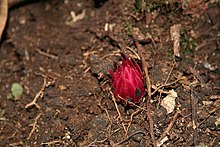莲花菰
| 莲花菰 | |
|---|---|

| |
| 莲花菰的花序 | |
| 科学分类 | |
| 界: | 植物界 Plantae |
| 演化支: | 维管植物 Tracheophyta |
| 演化支: | 被子植物 Angiosperms |
| 演化支: | 真双子叶植物 Eudicots |
| 目: | 檀香目 Santalales |
| 科: | 蛇菰科 Balanophoraceae |
| 属: | 莲花菰属 Thonningia |
| 种: | 莲花菰 T. sanguinea
|
| 二名法 | |
| Thonningia sanguinea | |
| 异名 | |
|
Thonningia coccinea | |
莲花菰(学名:Thonningia sanguinea)是属于蛇菰科莲花菰属的一种寄生植物,莲花菰属是一个单种属,属内只有莲花菰一个种。[1][2]分布遍及非洲南部和西部,尤其是非洲的热带地区特别多。[2][3]
莲花菰,俗称地凤梨(ground pineapple),[3][4]是一种非洲人非常熟悉的植物,在非洲的众多语言中它有着一长串各种不同的俗名,因为花序的外观像小型的凤梨或椰子树,这些俗名大多和凤梨或是椰子树有关。[5]
形态特征
[编辑]本种是雌雄异株的肉质草本植物,块茎生长在地底下,经由块茎寄生在宿主植物上。浅黄色的块茎生长在土壤中,会由块茎长出分枝,分枝水平延伸约10〜15公分长,在接触宿主植物根的地方会形成肿胀的瘿瘤,这些瘿瘤可以成长到18公分宽。[6] 块茎看起来很像是根状茎,但它们并不是真正的根状茎。茎上覆盖着鳞片状的叶片,鳞叶呈螺旋状排列。叶子颜色不是绿色的,没有叶绿素,因为养分是取自宿主植物,本身不需要进行光合作用制造养分。花茎直接由地底的块茎长出,皇冠状的花头覆盖着鳞片,花序鲜红色或粉红色,花单性,花序长15〜20公分。[2][5]
生态习性
[编辑]莲花菰生长在森林及其他的环境里。[5]常常可以在大型的农场里找到,它寄生在农场的作物上,例如:橡胶树,海枣,可可树。[7]
莲花菰是一种虫媒花,借由苍蝇和蚂蚁来传播花粉,这些昆虫有蝇科和丽蝇科的苍蝇及扁琉璃蚁属(Technomyrmex)的蚂蚁,当它们进入花内采蜜时,同时也为莲花菰进行了授粉。蝇科莫蝇属(Morellia)的苍蝇会将卵产在莲花菰的雄花上,卵孵化成幼虫后,幼虫就以雄花为食物。莲花菰与莫蝇形成了互利共生的关系,莫蝇帮助莲花菰授粉,莲花菰则提供莫蝇产卵的场所,并做为幼虫的食草为其提供食物。[8]
用途
[编辑]
莲花菰最广为人知的用途就是它可以做为药用植物,整株植物都可以做药材,是一种非洲的传统药用植物,在许多非洲文化中它被拿来治疗很多种疾病。[5]在加纳,用它来防止哮喘发作[9]和治疗性病。[5]在科特迪瓦和刚果它被拿来治疗腹泻。[10][11][5]叶子的煎剂用于治疗寄生虫。和辣椒合用做成外用药,用来治疗痔疮和斜颈症(torticollis)。[5]也可治疗痳疯病、皮肤感染、脓疮、龋齿、牙龈病、发烧、疟疾、[7]心血管疾病、佝偻病和风湿病。在萨伊,据说可以防止尿失禁和尿床。[5]
在实验室的研究发现,莲花菰具有一些药用功能。它具有抗菌活性,可以抗多种病原体。[10]对于会引起腹泻,有抗药性的肠道沙门氏菌菌株,它具有一些抗菌作用。[12]它可能有助于治疗经常伴随着感染人类免疫缺陷病毒与艾滋病出现的真菌性疾病。[13]它具有抗氧化活性。[14]它也许可以保护肝脏,防止黄曲毒素造成肝损伤。[9]对于一些会产生广效性乙内酰胺酶的病原体,例如大肠杆菌及克雷伯氏肺炎菌,在服用抗生素治疗这些病菌所产生的疾病时,添加莲花菰的提取物一起服用,可能有提高治疗效果的功效。[11]它有抗疟原虫属物种的作用,例如引起疟疾的恶性疟原虫。[7]莲花菰对于黑曲霉、白色念珠菌(Candida albicans)、枯草杆菌、绿脓杆菌、金黄色葡萄球菌、宋内志贺氏菌(Shigella sonnei)都具有抗菌活性。[15]
科特迪瓦的人民用来猎捕动物的箭毒,其毒药的成分就含有莲花菰。[5]它也可以做为煮汤时的调味料。[3]一些地区,它的花序被认为是一种春药。[5]在加纳与科特迪瓦,会将花序绑在幼儿的脚踝上,激励他们学习走路,因为花序上的尖刺会阻止他们坐下来。[4]
在某些地方,莲花菰被认为是一种杂草,例如在橡胶园里面大量生长的莲花菰就被认为是杂草。[16]
参见
[编辑]参考资料
[编辑]- ^ Nickrent, D. Parasitic Plant Classification. (页面存档备份,存于互联网档案馆) The Parasitic Plant Connection. Department of Plant Biology, Southern Illinois University, Carbondale.
- ^ 2.0 2.1 2.2 Leistner, O. A. (2005). Balanophoraceae. 互联网档案馆的存档,存档日期2008-11-21. Seed Plants of Southern Tropical Africa: Families and Genera. Southern African Botanical Diversity Network Report No. 26. pg 103.
- ^ 3.0 3.1 3.2 Seidemann, Johannes. Thonningia Vahl – Balanophoraceae. World Spice Plants: Economic Usage, Botany, Taxonomy. Springer. 2005: 364 [2014-10-13]. ISBN 978-3-540-22279-8. (原始内容存档于2014-07-04).
- ^ 4.0 4.1 Burkill, H. M. (1985). Thonningia sanguinea. The Useful Plants of West Tropical Africa, Vol 1. Royal Botanic Gardens, Kew.
- ^ 5.00 5.01 5.02 5.03 5.04 5.05 5.06 5.07 5.08 5.09 Neuwinger, Hans Dieter. Thonningia sanguinea Vahl. African Ethnobotany: Poisons and Drugs; Chemistry, Pharmacology, Toxicology. CRC Press. 1996: 249–51 [2014-10-13]. ISBN 978-3-8261-0077-2. (原始内容存档于2014-07-04).
- ^ Otoide, V. O. Thonningia sanguinea— a new parasite on rubber roots. Tropical Pest Management. 1982, 28 (2): 186. doi:10.1080/09670878209370698.
- ^ 7.0 7.1 7.2 Jigam, A. A., et al. (2012). Efficacy of Thonningia Sanguinea Vahl. (Balanophoraceae) root extract against Plasmodium berghei, Plasmodium chabaudi, inflammation and nociception in mice. (页面存档备份,存于互联网档案馆) Journal of Applied Pharmaceutical Science 2(1) 47–51.
- ^ Goto, Ryutaro; Yamakoshi, GEN; Matsuzawa, Tetsuro. A novel brood-site pollination mutualism?: The root holoparasite Thonningia sanguinea (Balanophoraceae) and an inflorescence-feeding fly in the tropical rainforests of West Africa. Plant Species Biology. 2012, 27 (2): 164. doi:10.1111/j.1442-1984.2011.00338.x.
- ^ 9.0 9.1 Gyamfi MA, Aniya Y. Medicinal herb, Thonningia sanguinea protects against aflatoxin B1 acute hepatotoxicity in Fischer 344 rats. Human & Experimental Toxicology. August 1998, 17 (8): 418–23. PMID 9756133. doi:10.1191/096032798678909007.[失效链接]
- ^ 10.0 10.1 Ouattara, K., et al. (2013). In vitro antibacterial activity of Thonningia sanguinea (Balanophoraceae (Vahl)) flowers extracts. (页面存档备份,存于互联网档案馆) Journal of Microbiology and Biotechnology Research 3(2) 83–87.
- ^ 11.0 11.1 N'guessan, J. D., et al. (2007). Antibacterial activity of the aqueous extract of Thonningia sanguinea against extended-spectrum-β-lactamases (ESBL) producing Escherichia coli and Klebsiella pneumoniae strains. (页面存档备份,存于互联网档案馆) Tropical Journal of Pharmaceutical Research 6(3) 779–83.
- ^ N'guessan JD, Coulibaly A, Ramanou AA, Okou OC, Djaman AJ, Guédé-Guina F. Antibacterial activity of Thonningia sanguinea against some multi-drug resistant strains of Salmonella enterica. African Health Sciences. September 2007, 7 (3): 155–8. PMC 2269722
 . PMID 18052869. doi:10.5555/afhs.2007.7.3.155 (不活跃 2014-04-13).
. PMID 18052869. doi:10.5555/afhs.2007.7.3.155 (不活跃 2014-04-13).
- ^ Ouattara B, Kra AM, Coulibaly A, Guede-Guina F. Efficacité de l'extrait éthanolique de Thonningia sanguinea sur Cryptococcus neoformans [Efficiency of ethanol of Thonningia sanguinea against Cryptococcus neoformans]. Santé. 2007, 17 (4): 219–22. PMID 18299265. doi:10.1684/san.2007.0086 (不活跃 2014-04-13) (法语).
- ^ Gyamfi MA, Yonamine M, Aniya Y. Free-radical scavenging action of medicinal herbs from Ghana: Thonningia sanguinea on experimentally-induced liver injuries. General Pharmacology. June 1999, 32 (6): 661–7. PMID 10401991. doi:10.1016/S0306-3623(98)00238-9.
- ^ Ouattara, B., et al. (2008). Assessment of antifungal activity of an African medicinal herb Thonningia sanguinea against Cryptococcus neoformans. (页面存档备份,存于互联网档案馆) World Applied Sciences Journal 3(2) 191–94.
- ^ Idu, M., et al. (2002). Anatomy of attachment of the root parasite Thonningia sanguinea Vahl. on Hevea brasiliensis. 互联网档案馆的存档,存档日期2013-07-01. Indian Journal of Rubber Research 15(1) 33–35.
